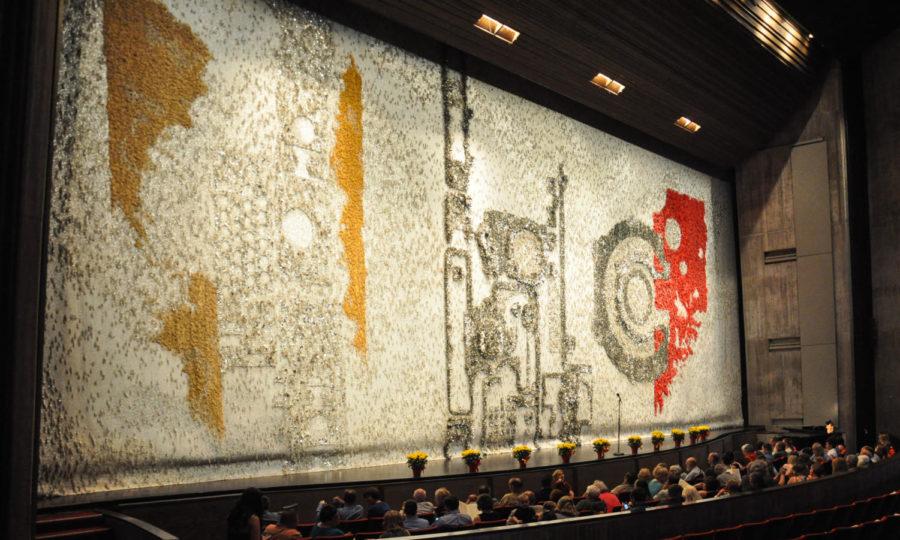Silver Code curtain restoration nears completion
The conservation of the Silver Code curtain hanging in Stephens Auditorium is nearing completion. Maintenance on the curtain started on Aug. 26, 2013.
April 16, 2014
The conservation of the Silver Code curtain hanging in Stephens Auditorium is nearing completion.
Maintenance on the curtain started on August 26, 2013.
Weighing in at about 3,000 pounds, the curtain was covered in a thick layer of dust. The challenging part of cleaning the fabric is cleaning the different types of fabric on the curtain. There are sections of red and yellow yarn and foil.
The curtain is made up of many layers so it is not porous, which has kept it from sagging while it stays hung up in the auditorium.
Rod pockets in the back of the curtain are also being replaced, the original holes from 1969 are being resewed.
Cleaning the curtain takes several steps. First, the conservation vacuum is used to take off the first layer of dust. Next paintbrushes and microfiber rags are used to pull off the leftover dust.
Katherine Greder, program coordinator for University Museums, began working on the project in August. Amy Lowery, a senior in anthropology, has been working on this project since September.
“It’s not rocket science, you’ve just got to be really patient,” Greder said.
Another part of the restoration project is research. Information is being found about the curtain and the recently found designer of the curtain.
While restoring the Silver Code, a signature was found woven into the curtain on the lower right side. The designer, Ryokichi Mukai, had named the curtain Giniro-no-kigou, which translates to silver code.
The meaning behind his design is still unknown.
“There’s been tons of speculation, don’t get me wrong, but we can’t corroborate anything,” Greder said.
The curtain took four months and seven people to make. Once the curtain was finished, it went on quite a journey to get to Ames.
The curtain left Kyoto, Japan rolled up in a crate that altogether weighted about 5,600 pounds. It crossed through the Panama Canal and then it traveled up the eastern seaboard and passed into the St. Lawrence Seaway between New York and Canada. From there, it went down the Great Lakes and to Chicago.
The trip that the Silver Code curtain took from Chicago to Ames is also unclear.
“We’re a little dubious as to how it got from Chicago to here. Train, rail, we’re not sure,” Greder said.
The 80-foot by 35-foot curtain hangs in Stephens Auditorium year-round. Silver Code used to be used in performances at Stephens, but now it mostly stays counter weighted above the stage and out of view.
Greder said the restoration was needed. This is the first restoration of the curtain since it was hung 45 years ago in 1969.
“It was definitely time to do it. At one point in time it was the talk of the town and it was a real symbol of [Stephens Auditorium] and the experience of coming to Stephens and seeing a show here,” Greder said. “It was tremendously glamorous and it had really lost its luster, so the goal of doing this is that it also brings back the memories of the time.”
Lowery says Iowa State students might not even know the curtain exists.
“I knew about it because my parents came here around the time it opened up for the first time, but several of my friends, when I told them that I was gonna work on this, they had no idea that it existed,” Lowery said. “I think that because it’s been used less and less. It’s come out of the spotlight a little bit. So hopefully this will bring it back to the spotlight.”
Greder said she hopes there can be some type of reveal when the project is finished, but there is nothing scheduled currently. There have been open houses for Silver Code, but most attendees were not students.
“Iowa State is great about having lots of art everywhere you go. Not just in one location like a museum, but all over the place. This is just one more amazing piece that people don’t seem to know about,” Greder said.
The Silver Code curtain will be finished at the end of April 2014.







